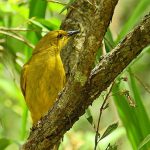YELLOW HONEYEATER
The Yellow Honeyeater is a small to medium-sized bird, measuring about 17 to 19 centimetres in length. As its name suggests, it boasts a striking plumage of bright yellow, which makes it quite a sight against the lush green backdrop of its habitat. Its feathers glisten under the sunlight, giving it a cheerful and lively appearance. The bird also has a slightly curved bill, perfectly adapted for its feeding habits.
This charming bird is predominantly found in the tropical and subtropical regions of North-eastern Queensland. It thrives in a variety of habitats, including mangroves, rainforests, and woodlands, where it can be seen flitting among the trees. The Yellow Honeyeater is quite adaptable, often seen in gardens and urban areas, provided there are plenty of flowering plants.
The breeding season for the Yellow Honeyeater generally occurs from August to January, coinciding with the Australian spring and summer. During this time, the female constructs a neat, cup-shaped nest made of bark, grass, and spider webs, often positioned in a sheltered fork of a tree. She typically lays two to three eggs, which she incubates for about two weeks. Both parents share the responsibility of feeding the chicks once they hatch.
The Yellow Honeyeater primarily feeds on nectar, which it extracts from a variety of flowering plants using its specialised brush-tipped tongue. This diet is supplemented by insects and spiders, providing essential proteins. Their role as pollinators is crucial, as they help in the cross-pollination of many native plants, contributing to the health of their ecosystem.
In the wild, Yellow Honeyeaters can live for several years, with some individuals reaching up to a decade or more, although precise data on their lifespan in the wild is limited.
The call of the Yellow Honeyeater is a delightful addition to its vibrant presence. It produces a series of melodious and rapid notes, often described as a sweet, tinkling sound. These calls are not only used for communication between mates and signalling territory but also add to the symphony of the Australian bush.


















